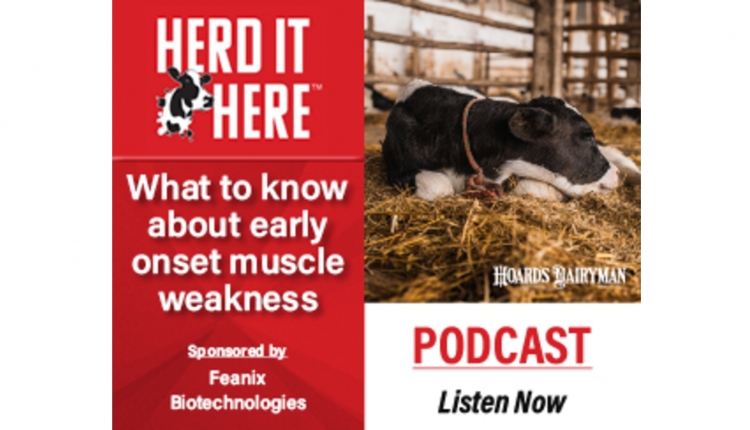
We have long known that there is a genetic antagonism between milk yield and the percentages of fat and protein. Bulls and cows with high predicted transmitting ability (PTA) for milk have tended to be lower than average when it comes to PTA fat percent. Cows that produce more pounds of milk still generally produce more pounds of fat, but their milk is less concentrated.
Genetic antagonisms between traits such as milk and fat percent have multiple causes. There are genes that simultaneously raise milk yield and lower fat percent. One example of this is a gene called DGAT1, which helps assemble fatty acids in the udder and other tissues. A mutation in the gene reduces how efficiently fatty acids are assembled. At the same time, the energy the cow would have used to make fat if DGAT1 was fully functional is available to support milk production. Thus, the “normal” version of the gene gives relatively high fat and low milk yield whereas the mutated version results in the opposite.
DGAT1 is the single largest effect that I am aware of contributing to the genetic antagonism between milk yield and milkfat percent, but it is far from the only one. Unfortunate gene linkages between high milk genes and low fat genes also occur if they happen to be physically located near each other along a chromosome. Such unfavorable physical linkages can be passed from parent to offspring for many generations.
Management plus genetics
This relationship makes recent trends in fat percentage even more interesting. As milk yield climbs, we might expect to see a slight decline in fat percent. However, that is clearly not the case (Figure 1). Fat percent has risen by 0.59% in Holsteins since genomic selection was implemented in 2009 and by 0.27% in Jerseys. Milk yield climbed by over 2,000 pounds in both breeds over the same time frame.

Figure 1 shows the phenotypic trends. Part of these trends are due to genetics and part are due to feeding and management. It appears that 0.19% of the change in Holsteins over the last decade was due to genetic selection and 0.40% was from nutrition and management. The genetic trend for Holsteins results from the strong emphasis on fat yield in our selection indexes. In the current version of net merit (NM$), fat yield has a 28.6% weight, making it the most heavily weighted trait in our selection programs.
For Jerseys, there was actually somewhat of a decline in genetic merit (-0.09%), which was offset by a positive change in nutrition and management of 0.36%. Because they are already a high-fat breed, perhaps Jersey breeders had less motivation to select for fat percent.
A changing relationship
One recent discussion delved into the relationship between milk yield and fat yield in elite genomic bulls and cows, positing that the genetic antagonism had diminished. To explore this change more fully, I have calculated the correlation between PTA milk and PTA fat percentage by birth year for bulls that were enrolled in an artificial insemination (A.I.) program (Figure 2).

You will note that the correlation between PTA milk and fat percent is negative, demonstrating there is a genetic antagonism. However, there is a notable change in the magnitude amongst Holstein A.I. bulls. The genetic correlation between milk yield and fat percent was approximately -0.60 for a long period of time and has declined in magnitude to about -0.30. In Jerseys, by contrast, we have seen very little change in that correlation over time.
We can only speculate as to the reasons behind this shift. Some of the change may simply be a reflection of the population of bulls enrolled in A.I. programs. Breeders are interested in bulls that are both high in milk and high in fat percentage; bulls that are high in yield but low in fat percent, or vice-versa, are less likely to be selected by a genetics company. Yet, high milk with high components is not a new goal by breeders, so it seems there are other factors in play. I suspect that genomic selection has elevated the frequency of the high fat version of DGAT1 and similar genes, and perhaps some unfavorable genetic linkages have been recombined so that high milk genes are now paired with genes more neutral for fat percent.
There is one note of caution in these trends. Bulls born prior to 2020 now have daughters in their genetic evaluation to validate their genomic prediction for milk yield and fat percent. Genomic evaluations for more recent bulls, on the other hand, are based almost entirely on DNA marker effects. We will need to wait a few years to see if the genetic antagonism has really been decoupled to the degree shown in Figure 2.
I was asked at the 2019 National Holstein Convention whether I thought it was possible to have Holsteins with as high of a fat percentage as Jerseys. I recall being somewhat skeptical it could happen rapidly. Holsteins haven’t completely closed the gap, but it is starting to look like I may have underestimated our ability to ramp up milk yield and components simultaneously!









